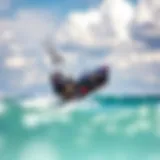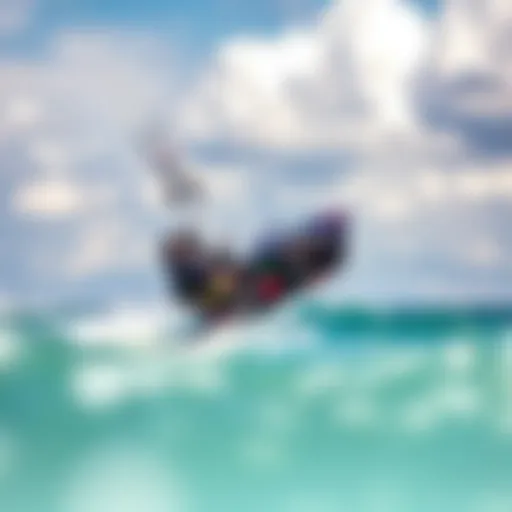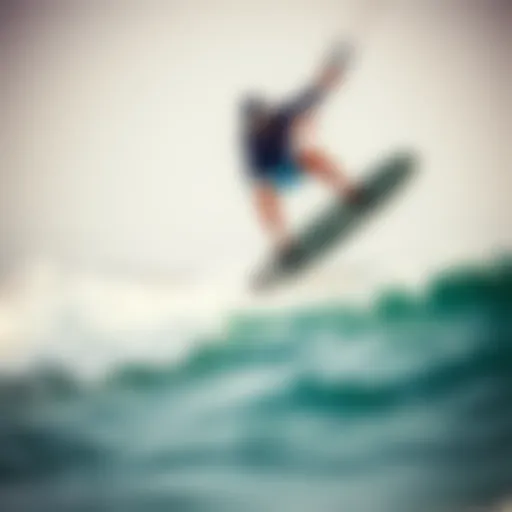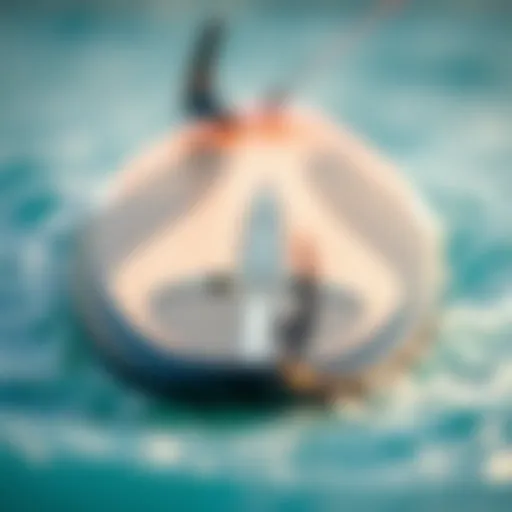Understanding Hydrofoil Sailboards: Key Insights
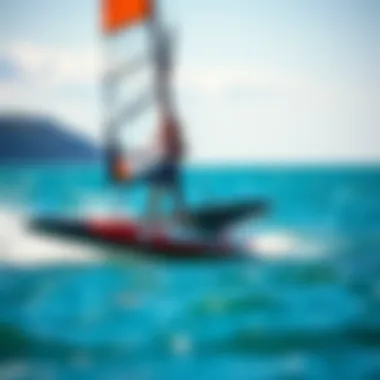
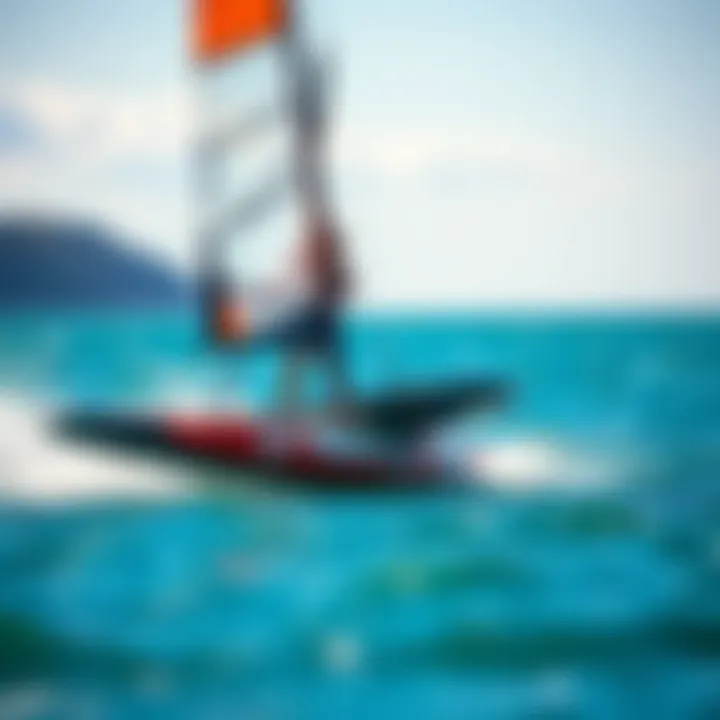
Intro
In the realm of water sports, hydrofoil sailboarding stands out as a brilliant convergence of wind, water, and engineering. For kiteboarding enthusiasts, mastering the art of hydrofoiling opens a new chapter in the adventure of riding the waves. This article seeks to illuminate the intricacies behind hydrofoil sailboards, unpacking both their appeal and the technical prowess needed to truly excel in this thrilling sport.
Hydrofoil sailboards provide a unique riding experience—one that lifts the board above the water surface, reducing drag and allowing for faster speeds and smoother navigation, even in choppy conditions. It's not just about the rush of speed, though; hydrofoiling also invites a deeper connection to the elements, as riders learn to harness the wind in innovative ways.
As we journey through the mechanics, advantages, and environmental considerations of hydrofoil sailboards, we aim to equip both novice and seasoned kiteboarders with critical insights. Whether adjusting your technique or selecting the right gear, understanding the nuances of hydrofoiling can significantly enhance your overall kiteboarding experience.
Techniques for Kiteboarding Enthusiasts
Beginner Techniques
Starting your hydrofoil journey often feels like stepping into an unfamiliar world. The buoyancy and lift brought on by the hydrofoil can be both exhilarating and daunting. Here’s how to navigate those initial waters:
- Start with Stability: Before even considering hydrofoils, familiarize yourself with basic kiteboarding. This includes mastering kite control, balance, and body positioning. Having a solid foundation will ease the transition to hydrofoiling.
- Choose the Right Conditions: Calm winds and manageable waves are key. Too much chop can lead to frustration, making it difficult to learn the nuances of the board.
- Practice on Flat Water: Flat water offers the most stable environment for practicing getting up on the foil. Once you’re comfortable, gradually introduce slight waves.
- Focus on Your Body Position: Maintain your weight centered and slightly forward; this ensures the hydrofoil lifts properly. Keep your knees bent to absorb any disruptions in the water.
- Falling Safely: Know that falling can be part of the learning curve. The hydrofoil can be somewhat intimidating when it comes to dismounting, so practice falling away from the board to minimize injury.
Advanced Maneuvers
For those looking to take their hydrofoiling skills to the next level, a variety of advanced techniques can be explored. Here are some key areas to focus on:
- Carving Turns: Once comfortable, practice transitioning your weight for smooth turns. Lean into the turn and shift your body weight to maintain lift on the hydrofoil.
- Jumping: Creating elevation and executing jumps requires confidence and timing. Start small, allowing yourself to get a feel for the foiling reaction before progressing.
- Tricks and Spins: Once secured with stability and jumps, explore tricks like the 360-degree spin. These maneuvers come with inherent risks, so proceed with caution.
- Harnessing Wind Changes: Understanding how to trim your kite in response to changing wind conditions can significantly enhance your control and maneuvering capabilities on the hydrofoil.
Equipment Reviews
Kite Reviews
Selecting the right kite for hydrofoiling is crucial. Not all kites are created equal, especially when factoring in the unique dynamics of hydrofoiling. Focus on kites that offer:
- Lightweight Materials: Kites designed for hydrofoiling need to be light to maintain glide and avoid dragging.
- Responsive Control: A kite with quick reactions allows for easier turns and adjustments, essential as you refine your techniques.
- Wider Wind Range: Kites that perform well across a range of conditions can keep your hydrofoiling experience enjoyable, even when conditions shift unexpectedly.
Board Reviews
When it comes to choosing a hydrofoil board, there are several features to consider:
- Foil Design: Look for a fuselage that balances rigidity with flex, providing stability without compromising performance.
- Board Size: Since size affects buoyancy, a larger board can ease the learning curve for beginners but may restrict maneuvers for advanced riders.
- Construction Materials: Prioritize durability, especially if you plan on tackling rough water conditions.
For more detailed reviews about specific kites and boards, you might want to check platforms such as Reddit and dedicated water sports forums.
"Hydrofoiling harmonizes skill, wind, and water, creating an exhilarating dance that celebrates the very essence of kiteboarding."
In understanding the objections and advancements in hydrofoil sailboarding, you define not just your form of adventure but also deepen your connection to the ocean. This integration of technology and technique broadens the horizons for kiteboarding enthusiasts everywhere. By continuously learning and adapting, you pave the way for a richer and more fulfilling experience on the water.
Prelude to Hydrofoil Sailboards
The world of hydrofoil sailboards represents an exciting intersection of technology and adventure. As kiteboarding continues to evolve, hydrofoiling stands out for its ability to enhance speed and maneuverability on water. This section delves into the importance of understanding hydrofoil sailboards, shedding light on their unique characteristics and the significant shift they engender in the sailing experience. Unlike traditional boards, hydrofoils lift above the water, reducing drag and allowing for smoother navigation over choppy waves.
This innovation not only transforms the way enthusiasts engage with the sport but also introduces new dynamics in learning and technique. Recognizing the foundational elements of hydrofoil sailboards—like their definition, historical evolution, and the reasons why they captivate the community—is crucial for anyone eager to elevate their skills and comprehension of kiteboarding.
Definition and Purpose
At its core, a hydrofoil sailboard incorporates a specialized design that enables the board to ride on a submerged wing-like structure. This structure, known as a hydrofoil, lifts the board above the water surface when sufficient speed is attained. The primary purpose of hydrofoils is to reduce water resistance, enabling a quicker and more exhilarating ride. This configuration provides riders a unique sensation, gliding effortlessly above the waves, unmarred by turbulence caused by water movement.
Besides speed, the hydrofoil offers enhanced stability and control. Its ability to maintain lift in various wind and water conditions allows for diverse sailing experiences, making it appealing for both novices and seasoned enthusiasts. In simple terms, hydrofoil sailboards redefine the parameters of what adventurers can expect from their outings on the water.
Historical Context
The history of hydrofoil technology traces back over a century, with various inventors experimenting with the principles of lift and drag in marine settings. Early iterations of the hydrofoil appeared in the early 1900s, primarily in the form of boats and then gradually trickling into the realm of wind-driven crafts. However, it wasn't until the late 20th century that hydrofoiling began gaining traction as a viable aspect of kiteboarding.
In the 1990s, niche groups of athletes, driven by a passion for innovation and performance, started to integrate hydrofoils into their gear. This movement paved the way for the development of specialized boards and designs tailored for this new, exhilarating experience. Today, thanks to ongoing advancements in materials and craftsmanship, hydrofoil sailboards have become more accessible, attracting a broader audience and sparking a surge in popularity within water sports communities around the globe.
Ultimately, understanding the evolution of hydrofoil technology offers valuable insights into its current application and future potential. It highlights how far kiteboarding has come and points to exciting prospects that lie ahead for enthusiasts eager to explore new dimensions in their sport.
Mechanics of Hydrofoil Sailboards
The mechanics of hydrofoil sailboards aren't just an intricate web of physics; they are the foundation that elevates the sport into a mesmerizing blend of skill and technology. Understanding these mechanics is essential for any enthusiast and instructor looking to push their kiteboarding to new heights. The beauty of these boards lies in how they leverage hydrodynamic principles to reduce drag and increase speed, allowing riders to glide smoothly above the surface of the water.
How Hydrofoils Work
Hydrofoils function on the principle of lift, akin to how an airplane wing operates. As water flows over the specially designed foils, a pressure differential is created between the upper and lower surfaces. This lift, generated by the foil's shape and angle, raises the board and the rider above the water. The moment the rider achieves sufficient speed, the board begins to rise. The enhanced lift allows for higher speeds and reduced drag, leveling up the overall kiteboarding experience.
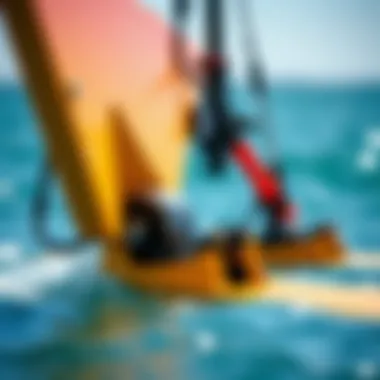
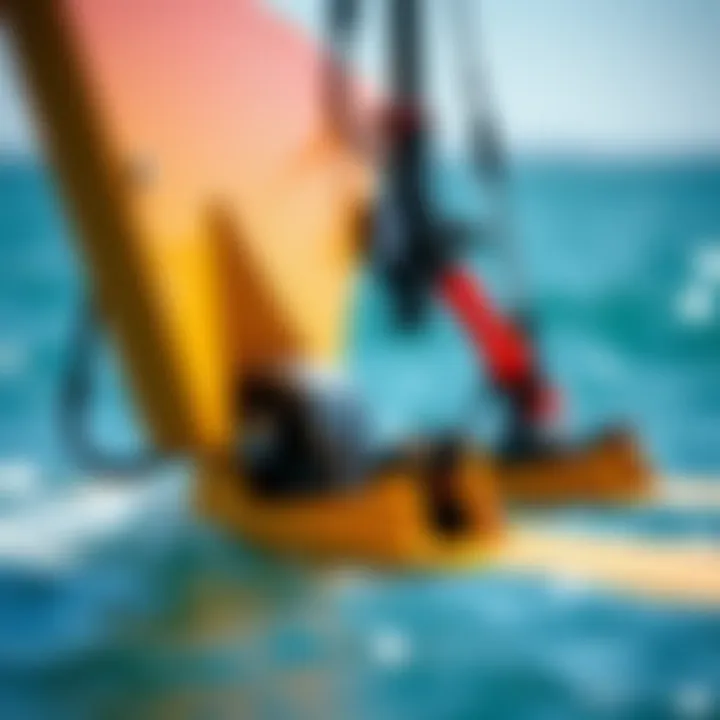
Key Components
Foil Types
Foil types can be a game-changer for riders. There are generally three categories of foils: low-aspect, high-aspect, and medium-aspect. Each has its own set of characteristics which directly impacts performance.
- Low-aspect foils: These typically have a shorter span compared to their chord length, providing enhanced maneuverability. This makes them ideal for choppy waters or beginner riders.
- High-aspect foils: Offering greater efficiency and speed, these are designed for experienced riders who are comfortable with sustained high-speed riding on flat water.
- Medium-aspect foils: A balanced choice, these options fall between low and high aspect ratios, making them versatile for all types of conditions and skill levels.
The key characteristic of these foils lies in their adaptability. A low-aspect foil might feel sluggish for advanced practitioners but will be more forgiving for newcomers who are still mastering the basics. Conversely, the cutting-edge performance of a high-aspect foil could lead to exhilarating rides for experienced users, opening doors to new tricks and maneuvers.
Board Design
The board design is another pivotal element. Most hydrofoil boards are shorter and wider than traditional boards. This specific design feature not only enhances stability but also aids in the control of the board when it's up in the air.
- Stability: A wider stance can make a significant difference as it helps balance the rider better during various maneuvers.
- Responsive: A shorter board generally provides a livelier response, allowing skilled riders to execute quick adjustments, which is essential in dynamic conditions.
- Customization: Many boards offer different foot strap positions to fine-tune the ride to personal preference, making it more comfortable for the user.
The downside? The trade-off between speed and control. A faster design might leave less room for error, while a more stable board could sacrifice some speed. However, for those passionate about optimizing their ride, understanding these design choices can lead to superior performance.
Sail Size and Shape
Sail size and shape might seem like minor details, but they play a crucial role in the overall mechanics as well. Hoisting a properly sized sail can affect both speed and responsiveness.
- Larger sails: These are advantageous in light wind conditions, as they can catch more air and generate more power to lift the board. However, they can also be cumbersome for skilled riders who prefer quick, sharp turns.
- Smaller sails: Best suited for windy conditions, they provide heightened maneuverability but demand more skill to fully harness their potential.
In terms of shape, sails can be flat or cambered. Flat sails tend to be easier to handle, making them suitable for novice kiteboarders. On the other hand, cambered sails offer more power and are preferred by experienced riders who can juggle the extra complexity.
In summary, mastering the mechanics of hydrofoil sailboards involves a blend of understanding how foils work, the influence of board design, and the critical role of sail size and shape. Each aspect multiplies the individual's capabilities on the water, making it essential for enthusiasts to consider these elements carefully when seeking to elevate their kiteboarding experience.
"Understanding your equipment can be the difference between simply riding the waves and truly harnessing the power of the wind and water."
As the world of hydrofoil technology continues to evolve, remaining attuned to these mechanics is vital for both beginners and veterans in the sport.
Advantages of Hydrofoil Technology
The allure of hydrofoil sailboards lies not just in their sleek design but also in the significant advantages they offer to those who dare to ride the waves. Understanding these perks is quintessential for kiteboarders, instructors, and anyone passionate about water sports. In this section, we will explore two major benefits: enhanced speed and reduced drag.
Enhanced Speed
Hydrofoil sailboards are engineered to slice through the water with precision, which directly translates to impressive speed. When a rider takes off, the hydrofoil lifts the board above the surface, allowing it to glide smoothly. This lift reduces water resistance, permitting the rider to reach higher velocities with less effort. The thrill of feeling the board elevate and race across the water is often compared to flying – it's exhilarating yet utterly captivating.
"Hydrofoiling is like surfing on a cloud; the sensation of speed combined with the absence of drag is intoxicating."
For those who are keen on performance, this jump in speed can mean a world of difference during competitive events or simply when racing friends. Riders have reported gains in overall speed of up to 50% compared to traditional setups. This is largely due to thefoil's innovative construction, which combines efficiency and agility. Moreover, fostering training to master speed control can take your riding to a whole new level.
Reduced Drag
A noteworthy aspect of hydrofoil sailboards is their ability to minimize drag. Traditional sailboards face significant resistance due to their proximity to the water surface. In contrast, hydrofoil boards lift away from this friction, akin to a bird soaring into the sky. The unique design of the foils invites an aerodynamic advantage, allowing the rider to harness the wind with greater efficiency.
This reduction in drag also means that less energy is required to maintain speed, making prolonged sessions less tiring. As kiteboarders can sustain higher speeds over extended periods, this opens up the possibility for longer, more enjoyable rides. It's worth noting that mastering the balance between speed and control is essential; too much speed without the savvy to manage it can lead to mishaps.
In sum, the dual benefits of enhanced speed and reduced drag are compelling reasons for enthusiasts to consider hydrofoil technology in their kiteboarding pursuits. Understanding and exploiting these advantages can not only improve performance but also elevate the overall experience of sailing on water.
Further Information
For anyone interested in learning more about the mechanics behind these innovations, reliable resources include Wikipedia on Sailboarding and Britannica's overview of Water Sports. Additionally, communities such as Reddit's Kiteboarding Subs are great for connecting with fellow riders and sharing insights.
Technique and Skill Development
Technique and skill development are crucial elements when it comes to mastering hydrofoil sailboarding. Unlike traditional windsurfing or kiteboarding where the board remains in contact with the water, hydrofoiling introduces a completely new dynamic. As the board raises above the water surface, riders encounter unique challenges and opportunities that necessitate a tailored approach to learning and refining their skills.
The journey of becoming proficient on a hydrofoil can be compared to learning a new language—initially, the mechanics appear complex, yet with continued practice and immersion, fluidity in movement develops. Investing time in technique improves overall performance, allowing riders to amplify their enjoyment while minimizing risks associated with the sport.
Initial Learning Curve
The initial learning curve for hydrofoil sailboarding can indeed feel like navigating through murky waters. Riders often experience a mixture of excitement and frustration as they adapt to the distinct sensations of rising above the waves. The first hurdle is achieving balance. It's not uncommon for beginners to feel a sensation akin to walking on stilts, where the board’s increase in height alters their center of gravity.
To ease the transition, instructors often emphasize:
- Proper stance: Keeping knees bent and weight centered helps stabilize the board.
- Vision: Keeping eyes focused ahead instead of down aids in maintaining balance.
- Controlled elevation: Gaining height gradually can prevent abrupt falls that might discourage a novice rider.
While every rider's pace is different, patience and perseverance pay off. The initial struggles often pave the way towards a rewarding and exhilarating experience. As a word to the wise, many have found that logging more practice hours, even if they result in tumbles, leads to faster skill acquisition.
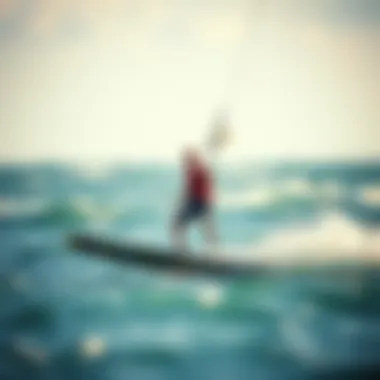
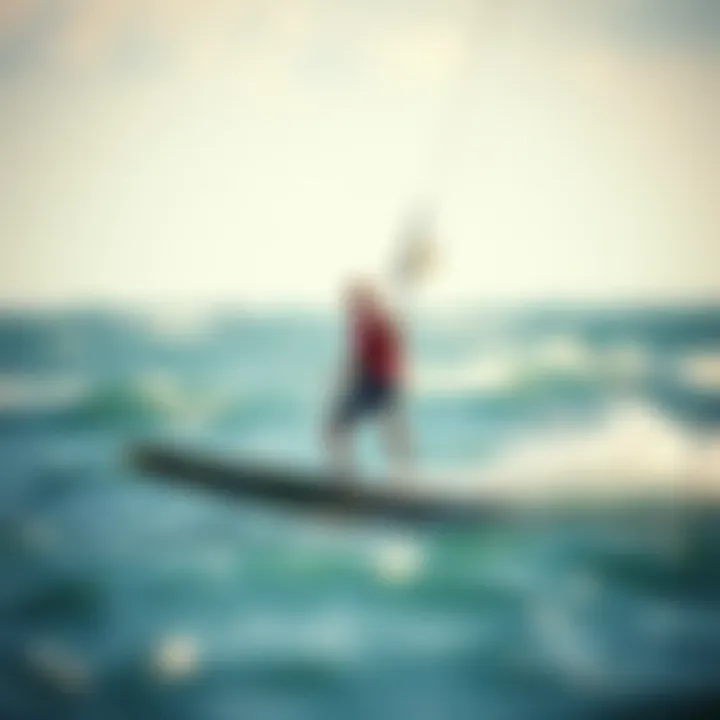
Advanced Maneuvers
Turning Techniques
Turning techniques take hydrofoil sailing to the next level, offering riders the ability to navigate with crisp precision. The flow of turning lies in the seamless transfer of weight, allowing the hydrofoil to pivot smoothly. Riders often favor carving turns, which involve leaning into the turn while guiding the board in a curved path.
One characteristic of effective turning is the need for agility; flexibility in body movements assists in adapting to the water's current and wave conditions. This technique is popular among experienced riders as it enhances control over the board while fostering creativity during sessions. However, riders must balance their eagerness to master turns with the potential risk of stalling if turns are too sharp or poorly executed, which could lead to an unceremonious drop back into the waves.
Jumping and Tricks
Jumping and tricks elevate hydrofoil sailboarding into an art form. Riders who master the skills of launching off the water can experience thrilling boosts of speed and height. This aspect not only brings a sense of freedom but also allows for creative expressions through aerial maneuvers.
An essential component of jumping is the timing of the take-off. Riders often emphasize the importance of compressing on the board before launching; when executed well, the hydrofoil can provide that extra lift needed for a successful jump. Enthusiasts often seek tricks that integrate spins or flips, creating a visually captivating performance. However, it's worth noting that jumping increases the risk of falling, especially when attempting more complex maneuvers. Understanding the capability of one's equipment and personal limits can mitigate these challenges.
Safety Considerations
Safety considerations are paramount in hydrofoil sailboarding, especially for those who are just starting out. With the combination of speed and elevation, the stakes can be higher, making it critical for riders to prioritize safety measures.
Essential safety tips include:
- Wear protective gear: Helmets and impact vests can protect against unexpected falls.
- Know your environment: Being aware of water conditions, currents, and other watercraft can prevent accidents.
- Understand your equipment: Familiarity with the hydrofoil setup and its maintenance can reduce malfunctions during rides.
Furthermore, riders should always practice with a buddy or within a supervised area when starting out. All in all, while the essence of hydrofoil sailing holds the promise of exciting adventure, prioritizing safety will ensure longer and more enjoyable sessions on the water.
Selecting the Right Hydrofoil Sailboard
Finding the perfect hydrofoil sailboard is kind of like picking your soulmate. You want something that fits you just right. It should complement your style, skill level, and the conditions you plan to tackle. Many kiteboarders, when they first dive into the hydrofoil scene, can feel overwhelmed by what’s available. This section will break it down – some key elements in choosing the appropriate board, the advantages it brings to your ride, and a few considerations to keep in mind.
Choosing the right hydrofoil sailboard greatly influences both performance and enjoyment on the water. A well-suited board can enhance speed, agility, and control, while a poor choice might leave you feeling frustrated and less confident.
Board Sizing and Fit
When it comes to sizing, it’s important to remember that a hydrofoil is not a one-size-fits-all deal. It’s crucial to consider both your weight and riding style. A larger board usually provides more stability which can be helpful for beginners. However, it may lose some agility on sharp turns.
On the flip side, a smaller board can be more responsive, which is great for advanced riders wanting to hone their tricks or make tight turns. Here are a few things to keep in mind:
- Weight Capacity: Most brands offer sizing charts that track board dimensions against rider weight.
- Board Volume: Higher volume boards can help with buoyancy, making it easier to get up and riding.
- Shape Preference: Different shapes cater to different styles—do you want to cruise smoothly or carve aggressively? The shape also affects how the board handles chop.
Finding the right fit is a game-changer. It’s about getting on the water and feeling in sync with your board.
Material Choices
Hydrofoil boards are crafted from an array of materials, each having its own pros and cons. Material choice impacts durability, weight, and performance. Here’s a look at some common materials:
- Epoxy: Lightweight and often used for performance boards. Offers a good balance of flexibility and stiffness.
- Fiberglass: This offers durability and flexibility, giving it a nice performance feel without the fragility of EPS foam.
- Carbon Fiber: Known for being super light and strong. This is often used by advanced riders seeking the best performance but comes with a higher price tag.
Making an informed decision about materials can ultimately boost the hydrofoiling experience, helping you glide gracefully across waves or make sharp turns with confidence.
Choosing the right hydrofoil sailboard is about understanding your needs and preferences. With thoughtful consideration, you’ll find yourself buzzing across the water, catching air, and having the time of your life.
"A well-chosen board is like having a reliable friend – it supports you when you fall and encourages you to soar!"
Popular Brands and Models
When venturing into the world of hydrofoil sailboards, it's essential to familiarize yourself with the brands and models that dominate the market. Not only do these brands shape the industry, but they also play a crucial role in the performance and overall experience of kiteboarders. Each manufacturer brings with it a unique blend of technology, design philosophy, and user feedback, ensuring that there's a suitable hydrofoil for nearly every rider's preference and skill level.
Industry Leaders
A handful of brands have solidified their place at the top of the hydrofoil market due to their remarkable innovations and consistent quality. Key players include:
- Naish: Known for their rigorous testing and reliable performance. Their hydrofoil boards often feature state-of-the-art technology that guarantees stability and speed.
- Slingshot: This brand has made a name for itself in the kiteboarding community by combining advanced materials with superior design. Slingshot boards cater to various skill levels, making it easier for everyone from beginners to pros to find their fit.
- Liquid Force: With a reputation established over decades, Liquid Force continues to innovate. Their focus on user-friendly designs helps new riders get accustomed to hydrofoiling more quickly.
Industry leaders often invest significantly in research and development, ensuring that they stay ahead of the curve with cutting-edge designs that enhance user experience. As result, riders can expect high-performance boards that are not only efficient but also built to withstand the rigors of varied water conditions.
"The right equipment can transform your experience on the water, making learning enjoyable and progression seamless."
Emerging Options
While established brands lead the charge, a number of emerging players are beginning to carve out their own niches in the hydrofoil market. These brands often bring fresh ideas and perspectives that challenge traditional designs. Consider the following up-and-coming labels:


- Armada: This company is quickly gaining traction by emphasizing environmental sustainability in their manufacturing processes. They utilize materials that minimize ecological impact while maintaining high performance.
- Foil 2 Fly: Known for their lightweight designs, Foil 2 Fly is attracting attention from those looking for nimble boards that facilitate sharp turns and quick maneuvers in the water.
- Moses: An Italian brand that prides itself on craftsmanship and innovation. They offer a range of hydrofoils that cater to various riding styles and preferences.
These emerging options not only capitalize on technology but also tailor their offerings based on direct feedback from users. They often take decisive steps to ensure their models are accessible and appealing to younger riders and newcomers to the sport.
For further exploration, refer to resources like Wikipedia, Britannica, and discussions on Reddit that delve deeper into the nuances of hydrofoiling.
Environmental Impact of Hydrofoiling
Understanding the environmental impact of hydrofoiling is essential for enthusiasts who are passionate about both performance and sustainability. As kiteboarders take to the water with their hydrofoil sailboards, it's crucial to contemplate how these innovative designs interact with marine ecosystems and the materials used in their production. By embracing a conscientious approach, both riders and manufacturers can contribute positively to the environment.
Sustainable Manufacturing Practices
The journey begins with the materials that make up hydrofoil sailboards. In recent years, there’s been a notable shift toward sustainable manufacturing practices in this market. For instance, manufacturers are starting to use recyclable materials such as epoxy resins derived from renewable sources and aluminum that isn't mined but recycled. This approach doesn’t just reduce the ecological footprint but also encourages innovation in product design.
Some of the more progressive companies are integrating these eco-friendly materials into their product lines, combining performance with a lesser impact on the planet.
- Compostable Packaging: Many brands are rethinking how they package their products. Instead of plastic, they're leaning towards compostable materials that will break down without adding to landfill waste.
- Local Sourcing: Using local resources helps decrease transportation emissions and supports local economies. When a brand utilizes nearby suppliers, it fosters a more sustainable supply chain while providing jobs to the community.
The ultimate goal is to create a product that not only thrives in the water but also allows the very ecosystem it relies on to flourish.
Protecting Marine Ecosystems
Another crucial aspect of the environmental impact of hydrofoiling is the responsibility of riders on the water. Learning how to navigate safely with minimal disruption to marine life becomes paramount. Hydrofoiling itself creates less wake compared to traditional boards, but it's still vital to be mindful of where one rides.
There are several practices that can help protect marine ecosystems:
- Observe Wildlife Spots: Avoid areas known for wildlife gatherings, especially during breeding seasons. This small consideration may prevent disturbances that could affect the local animal population.
- Choose Eco-Friendly Locations: Opt for hydrofoiling spots that are flagged for their environmental management, ensuring you're contributing to sustainable water usage.
- Community Engagement: Lift your voice within your community. Working alongside local agencies or conservation groups can ensure that water sports do not negatively influence delicate habitats.
By adopting such practices, hydrofoil riders can enjoy the thrill of their sport while being stewards of the environment. It's about striking a balance: enhancing human experiences on the water while minimizing the impact on the world below.
For more information on water sports sustainability, you can visit NOAA's Marine Life and Shorelines page, or explore comprehensive guides on responsible water recreation provided by The International Windsurfing Association.
Future Innovations in Hydrofoil Technology
In the ever-evolving landscape of water sports, hydrofoil technology stands out for its innovative approach to enhancing performance on the water. The future of hydrofoil design and functionality is not just about speed; it encapsulates broader goals like sustainability, improved safety, and greater accessibility. As more kiteboarders embrace this technology, it becomes critical to focus on what the next wave of innovations holds for enthusiasts and professionals alike.
Ongoing Research and Development
The realm of hydrofoil sailboards is ripe with opportunities, as ongoing research keeps pushing the boundaries of what is possible. Engineers and designers are investing significant time into developing new materials that are lighter yet more durable. For instance, advancements in carbon fiber technology have the potential to produce boards that are both flexible and robust, enhancing user experience.
Moreover, aerodynamics continues to play a pivotal role. Researchers are experimenting with new foil shapes and sizes to maximize efficiency and speed. A recent study explored how varying the angle of attack on the foils can substantially improve lift, indicating exciting prospects for the customization of ride experiences.
Notably, water resistance patterns are also under investigation. It has been observed that tweaking the surface texture of foils can impact drag, thus contributing to enhanced speed. Collaboration with data scientists has allowed developers to use algorithms to simulate how different designs perform in various conditions, ultimately refining the design process.
User-Driven Modifications
While industry innovations carry significant weight, the input from seasoned riders is equally valuable in shaping the future of hydrofoil technology. Users are increasingly engaging in DIY modifications that reflect their personal preferences, leading to a more tailored riding experience. This phenomenon shifts the focus from purely manufacturer-driven design to a more user-centric approach.
For instance, some users have developed custom fin setups that allow for better control during tricks and turns. By experimenting with different foils, they can achieve personalized balance and responsiveness, which standard models may not always provide. Furthermore, communities and forums, like those found on Reddit, have sprung up to support this sharing of information, where riders swap tips and showcase their unique adaptations.
Engaging actively with product reviews and peer feedback, users often share ideas on how to enhance existing boards or incorporate new features. For example, a rising trend is the integration of tech features such as GPS tracking systems or performance analytics tools. These modifications allow riders to not only monitor their performance but also to share it within their communities, fostering a culture of continual improvement.
"As our understanding of hydrodynamics deepens, so too does the potential for a future where every hydrofoil board is uniquely aligned with the rider’s personal style and needs."
In summary, as we cast an eye toward the horizon, the realities of ongoing research coupled with user creativity signal an exciting period for hydrofoil technology. With a focus on performance, safety, and personalization, future hydrofoil innovations promise to redefine what riders can achieve on the water.
Epilogue
The world of hydrofoil sailboarding is one that marries thrill with technique, appealing to both seasoned pros and those eager to glide along the water’s surface for the first time. This article has journeyed through essential elements that contribute to a deeper understanding of hydrofoil technology. It's not just about the boards and sails, but rather, it encapsulates a culture of innovation and adaptation that continuously evolves with the sport.
Summary of Key Points
1. Understanding Mechanics and Performance
The mechanics of hydrofoiling serve as the backbone of performance. Key components, such as different types of foils and board designs, factor significantly into how effectively a rider can harness wind power. Through understanding these mechanics, one can significantly enhance their hydrofoil experience.
2. Advantages that Elevate the Sport
Hydrofoil technology minimizes drag and increases speed, allowing riders to skim over the water, reducing resistance and maximizing their potential. Not only does this enhance the experience, but it also opens up new horizons for what can be achieved on the water.
3. Safe Practices for All Skill Levels
Safety is paramount when engaging in hydrofoil sailboarding. Understanding the techniques for safe riding and having control over one's equipment not only ensures a thrilling experience but also protects riders from potential hazards associated with the sport.
4. Environmental Considerations
The ecological impact of hydrofoiling is a critical discussion point. Implementing sustainable practices helps in preserving marine environments while promoting a sport that thrives on natural elements.
5. Looking Ahead: Innovations and Developments
The future of hydrofoil sailboarding looks promising, driven by ongoing research and input from enthusiasts. Adaptations and user-driven modifications signal a trend toward customization that could reshape the sport as we know it.
The Future of Hydrofoil Sailboarding
The evolution of hydrofoil sailboarding seems to be on an upward trajectory, fueled by innovations that challenge the boundaries of design and performance. Breakthroughs in material technology can lead to lighter, more durable boards, enhancing the riding experience.
Moreover, the increasing popularity of this sport is likely to draw in new talent from diverse backgrounds, bringing fresh ideas and techniques into the fold. This blend of tradition and innovation makes for a vibrant community ripe for sharing knowledge.




